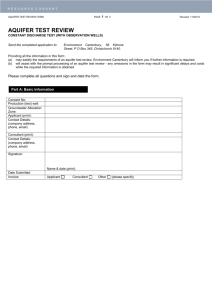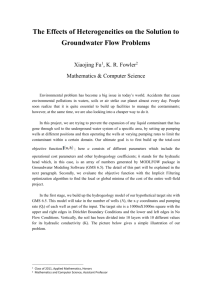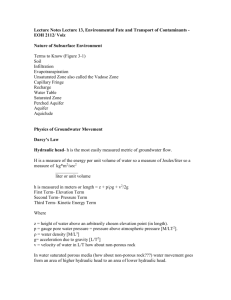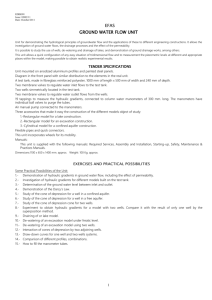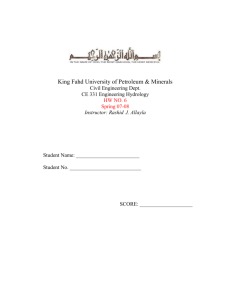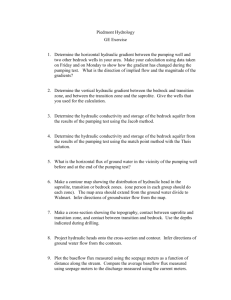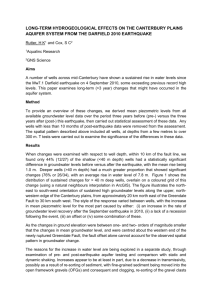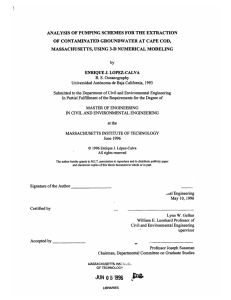A Brief Primer
advertisement
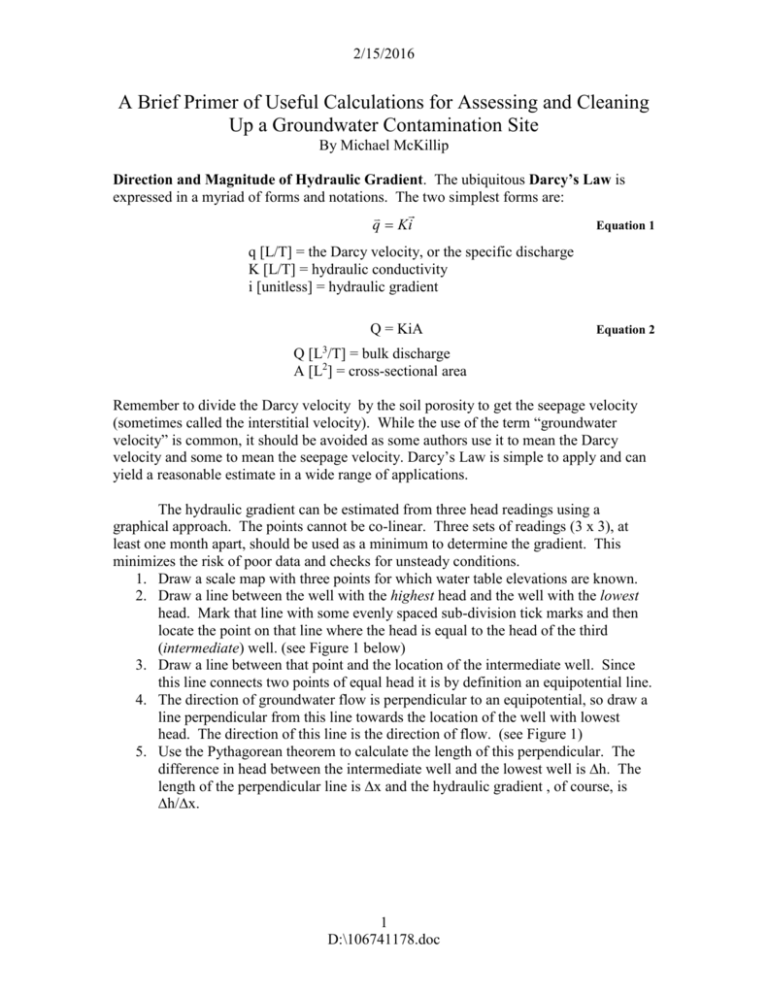
2/15/2016 A Brief Primer of Useful Calculations for Assessing and Cleaning Up a Groundwater Contamination Site By Michael McKillip Direction and Magnitude of Hydraulic Gradient. The ubiquitous Darcy’s Law is expressed in a myriad of forms and notations. The two simplest forms are: Equation 1 q Ki q [L/T] = the Darcy velocity, or the specific discharge K [L/T] = hydraulic conductivity i [unitless] = hydraulic gradient Q = KiA Equation 2 Q [L3/T] = bulk discharge A [L2] = cross-sectional area Remember to divide the Darcy velocity by the soil porosity to get the seepage velocity (sometimes called the interstitial velocity). While the use of the term “groundwater velocity” is common, it should be avoided as some authors use it to mean the Darcy velocity and some to mean the seepage velocity. Darcy’s Law is simple to apply and can yield a reasonable estimate in a wide range of applications. The hydraulic gradient can be estimated from three head readings using a graphical approach. The points cannot be co-linear. Three sets of readings (3 x 3), at least one month apart, should be used as a minimum to determine the gradient. This minimizes the risk of poor data and checks for unsteady conditions. 1. Draw a scale map with three points for which water table elevations are known. 2. Draw a line between the well with the highest head and the well with the lowest head. Mark that line with some evenly spaced sub-division tick marks and then locate the point on that line where the head is equal to the head of the third (intermediate) well. (see Figure 1 below) 3. Draw a line between that point and the location of the intermediate well. Since this line connects two points of equal head it is by definition an equipotential line. 4. The direction of groundwater flow is perpendicular to an equipotential, so draw a line perpendicular from this line towards the location of the well with lowest head. The direction of this line is the direction of flow. (see Figure 1) 5. Use the Pythagorean theorem to calculate the length of this perpendicular. The difference in head between the intermediate well and the lowest well is ∆h. The length of the perpendicular line is ∆x and the hydraulic gradient , of course, is ∆h/∆x. 1 D:\106741178.doc 2/15/2016 Figure 1: Graphical determination of the hydraulic gradient using three wells. Simple Guidelines For The Sizing And Placement Of Pumping Wells. Pumping wells are often also referred to as production wells, extraction wells, and treatment wells. The following guidelines are based on the usual assumptions of homogeneous, isotropic media, vertically well-mixed contamination, uniform aquifer bottom elevations, and fully penetrating wells, (i.e., screened over the full aquifer thickness). To control the migration of a plume (sometimes called a concentration plume or contaminant plume), the minimum total pumping rate should be the amount of water passing through the plume’s maximum cross-sectional area, which is the maximum plume width times the aquifer saturated thickness. The needed pumping rate can be determined using Darcy’s Law. Note that the pumping will increase the gradient, so the minimum is really somewhat larger than the pre-pumping discharge rate. A method to estimate a well’s capture zone follows. For multiple wells, superposition can be applied. x y 2 K b i y tan Q Equation 3 x, y = Cartesian coordinates where the origin is at the well K = average hydraulic conductivity [L/T] b = aquifer thickness [L] i = prepumping hydraulic gradient [unitless] Q = well pumping rate [L3/T] The distance to the downgradient stagnation point is given by: xO Q 2 K b i Equation 4 The maximum half-width of the capture zone (as x approaches infinity) is given by: 2 D:\106741178.doc 2/15/2016 y max Q 2 K bi Equation 5 Example: Given the following aquifer parameters: Ft3/day Ft Ft/day ft/ft Q b K i 20000 100 1000 0.005 Then x0 is 6.4 ft, and ymax is 20 ft. The edge of the capture zone is plotted in Figure 2. y-axis (transverse to flow direction) (feet) 25 20 15 10 5 0 -20 -5 0 20 40 60 80 100 120 140 -10 -15 -20 -25 x-axis (aligned with the flow gradient) (feet) Figure 2: Capture zone plot. The pumping well is at the origin. The hydraulic gradient slopes from right to left. The down gradient stagnation point is at the vertex with the x-axis. Javandel and Tsang (1986) determined the optimal transverse spacing of identical wells, as shown in Table 1. Note that the pumping rate, Qn, is for the individual well. This spacing prevents contamination “slipping” between the wells. Number of extraction wells 1 2 3 4 Optimal transverse distance between adjacent wells ---0.32 Qn/(Kbi) 0.40 Qn/(Kbi) 0.38 Qn/(Kbi) Maximum width of the capture zone at the line of the wells 0.5 Qn/(Kbi) 1.0 Qn/(Kbi) 1.5 Qn/(Kbi) 2.0 Qn/(Kbi) Table 1: Characteristic distances of a capture zone for treatment wells. Modified from Javandel, I. and Tsang, C. Groundwater, 24(5), 616-625, 1986. 3 D:\106741178.doc
